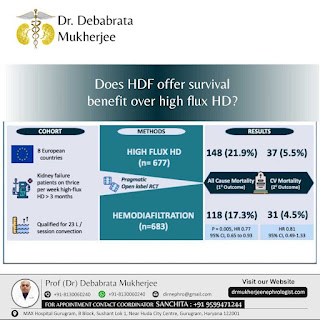Does Hemodiafiltration offer survival benefit over high-flux hemodialysis?
Both hemodiafiltration (HDF) and high-flux hemodialysis (HD) are renal replacement therapies used in the treatment of end-stage renal disease (ESRD). They are both forms of hemodialysis, which involves the removal of waste products and excess fluids from the blood when the kidneys are no longer able to perform these functions adequately.
Lets Understand the terminology
HDF is a form of hemodialysis that incorporates convective transport for enhanced clearance of larger substances. However, individual patient medical conditions may influence the choice of renal replacement therapy. The decisions should be made in consultation with the professional based on the patient's specific needs and circumstances.
For more information : Contact Dr. Debabrata Mukherjee, best nephrologist in Delhi

Comments
Post a Comment